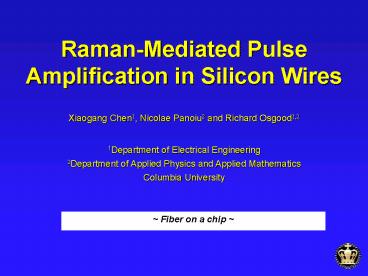RamanMediated Pulse Amplification in Silicon Wires
1 / 16
Title:
RamanMediated Pulse Amplification in Silicon Wires
Description:
Raman-Mediated Pulse Amplification in ... Red arrow points to [100] direction. Waveguide w=0.45 m, h=0.22 m. 50 mm ... Start with coupled Maxwell's equations ... –
Number of Views:49
Avg rating:3.0/5.0
Title: RamanMediated Pulse Amplification in Silicon Wires
1
Raman-Mediated Pulse Amplification in Silicon
Wires
Fiber on a chip
2
Outline
- Introduction
- Characteristics in SOI nanowire waveguide
- Waveguide structure and supported propagation
mode - Dispersion effect in silicon nanowire waveguide
- Third order nonlinearity in silicon
- Theoretical modeling of Raman amplification in
silicon - Coupled mode equations that models stimulated
Raman scattering in nanowire - Numerical simulation results
- Conclusions
3
Raman Emission in Si Nanowires(collaboration
with Yuri Vlasov and Sharee McNab, IBM)
- Silicon exhibits Raman effect
- nR 15.6 THz Dn105 GHz
- Si/SOI advantages for Raman emission
- SRS-gain coefficient of silicon 104? larger than
silica - High-index-contrast/confinement ? high intensity
Smaller Raman amplifier in SOI waveguides!
4
Nanowire waveguides
Nanowire waveguide support E11x mode.
x-component dominant. Most energy (90)
confined in waveguide
The input facet is in the (110) surface of
silicon. Red arrow points to 100 direction.
Waveguide w0.45µm, h0.22µm.
- Properties of the nanowire waveguide
- Ultrasmall waveguide cross-section (0.1 µm2),
tight optical confinement - High power density, enhanced nonlinearity
with Y. Vlasov, S. McNab, IBM
5
Dispersion can be engineered in nanowire
waveguides!
- Waveguide dispersion dominates material
dispersion. - First-order dispersion determines
pulse-interaction length (walk-off) - Second-order material dispersion positive in
C-band, while can be either positive or negative
for nanowires. Dispersion-free nanowire can be
realized for specific ?.
6
Third order nonlinear processes in silicon
- Electronic
- Raman
Parametric processes (SPM, XPM)
real
?e(3)
imaginary
4th rank tensor
TPA
Energy transfer between pump and Stokes pulse
?R(3)
4th rank tensor
7
Free-carrier (FC) effects in Silicon
- Carrier generation by two-photon absorption
- Free-carrier-induced optical properties (Drude
Model)
- Additional loss mechanism
- Four processes possible but absorption of two
pump photons dominates. - Is described by imaginary part of ?(3)
- Free-carrier absorption (FCA) through interaction
between FC and incoming field - Dielectric constant changes because of FC phase
shift
8
Modeling SRS in SOI nanowire
- Start with coupled Maxwells equations
- Perturbations SRS, Kerr effect, TPA, and
dielectric-constant change. - Linear loss and free-carrier generation included
- Response time of different interactions
- 10(s)fs for electronic and 10ps for Raman
- Additional assumptions
- Slowly varying envelope for all fields
- Keep dispersion term to second order
- Include only third-order nonlinearity.
(second-order nonlinearity vanishes due to
inversion symmetry)
9
Normalized Coupled Mode Equations for long pulse
(gt10ps)
10
Noise-seeded Raman generation in SOI nanowire
waveguide (no loss)
Time domain
Frequency domain
Pp 0.1mW Ps10-8W L5LR1.92cm T0 30ps ain
0
80
- Verify the generation of Raman signal from noise
- When Raman signal is strong, its interaction
with the pump causes the temporal profile
modulation for the pump pulse
11
Noise-seeded Raman generation in Silicon nanowire
(with loss) build-up in laser
Time domain
Frequency domain
Pp 0.1mW Ps10-8W L5LR53.83mm T0
30ps ain 3.5dB/cm
15
- Pump attenuation due to loss, amplification is
smaller for signal - Signal is not strong enough to significantly
change pump profile
12
Raman amplification vs. pump power in nanowire
waveguide
Ps10-8W L2.0cm T0 30ps
0.5dB/cm
0dB/cm
3.5dB/cm
- Threshold increases with the intrinsic loss
- Amplification saturates at high pump power
13
Free Carrier Density for the previous two cases
- FCD change in time is determined by pump
- Strong Raman signal contributes to the free
carrier generation - With loss, the FCD decreases along the waveguide
- At these power levels ?n lt 10-9, ?a lt 10-5,
FC effects not important
Nanowires have short recom times!!
14
Raman interaction of large signal and long pulse
(30ps) in SOI nanowire Raman Amplifier
Time domain
Frequency domain
Pp 0.1mW Ps0.05mW L5LR1.92cm T0 30ps ain
3.5dB/cm
- Pump depletes fast due to energy transfer to the
signal and loss - Signal amplification and loss balanced to define
a optimum amplification length
15
Raman interaction of large signal and short pulse
(2ps) in SOI nanowire Raman Amplifier
Time domain
Frequency domain
Pp 0.1mW Ps0.05mW L16LR 6.13cm Lw4.76cm T
0 2ps ain 0 dB/cm
- Walk-off length is comparable to waveguide
length, significant asymmetric depletion and
pulse reshaping for the pump - Energy transferring mostly happens in the first
few Raman lengths
16
Conclusions
- Rigorous coupled-mode analysis of SRS in Silicon
nanowire waveguide Raman signal generation and
amplification pulse shaping - Waveguide dispersion dominates material
dispersion significant dispersion engineering
possible! - TPA and FCA effects are not prominent in the
silicon nanowire waveguide - Raman-mediated pulse interaction show different
dynamic behavior for long and short pulses































